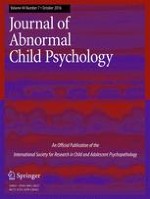19-01-2016
Emotion Socialization in Anxious Youth: Parenting Buffers Emotional Reactivity to Peer Negative Events
Gepubliceerd in: Research on Child and Adolescent Psychopathology | Uitgave 7/2016
Log in om toegang te krijgenAbstract
Anxious youth exhibit heightened emotional reactivity, particularly to social-evaluative threat, such as peer evaluation and feedback, compared to non-anxious youth. Moreover, normative developmental changes during the transition into adolescence may exacerbate emotional reactivity to peer negative events, particularly for anxious youth. Therefore, it is important to investigate factors that may buffer emotional reactivity within peer contexts among anxious youth. The current study examined the role of parenting behaviors in child emotional reactivity to peer and non-peer negative events among 86 anxious youth in middle childhood to adolescence (Mean age = 11.29, 54 % girls). Parenting behavior and affect was observed during a social-evaluative laboratory speech task for youth, and ecological momentary assessment (EMA) methods were used to examine youth emotional reactivity to typical daily negative events within peer and non-peer contexts. Results showed that parent positive behaviors, and low levels of parent anxious affect, during the stressful laboratory task for youth buffered youth negative emotional reactivity to real-world negative peer events, but not non-peer events. Findings inform our understanding of parenting influences on anxious youth’s emotional reactivity to developmentally salient negative events during the transition into adolescence.
